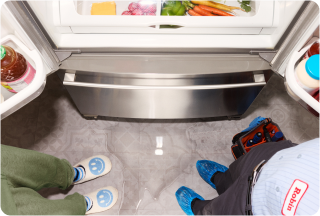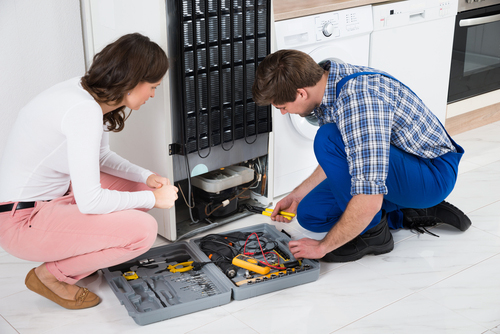Your refrigerator does the heavy lifting in your kitchen, keeping your food fresh and your drinks cold all day, every day. But how often do you show it a little love? With a routine refrigerator maintenance checklist, you can keep it running smoothly, extend its life, and avoid those unexpected breakdowns that always seem to happen at the worst possible time.
Refrigerator maintenance tips to help you keep your cool
On average, a refrigerator can last between 10 and 18 years. How long yours sticks around depends a lot on how well you maintain it. Understanding common appliance breakdowns can provide insight into potential issues; learn more in our Appliance Breakdowns by the Numbers article. If your refrigerator routine stops at restocking groceries, it might be time to reconsider your approach.
Your refrigerator is one of the few household appliances that run continuously—keeping your ice cream frosty, your veggies crips, and your leftovers just the right side of “still good.” But like any appliance, a timely checkup goes a long way in ensuring your fridge keeps its cool.
Taking a few minutes to perform some simple fridge maintenance tasks regularly will help your unit run more efficiently, saving on energy costs and expensive refrigerator repair bills and minimizing wear and tear.
Here is a refrigeration maintenance checklist that will make your fridge the coolest on the block:
1. Clean the coils
The coils play a crucial role in your fridge’s cooling system, helping to release heat as the refrigerant passes through them. Over time, they collect dust, debris, and pet hair, which makes your fridge work harder and use more energy.
You can typically find the coils on the bottom or back of your fridge. If yours are in the back, you’ll need to move the refrigerator away from the wall—don’t be surprised if you discover a long-lost dog treat or a few crumbs in the process.
You can purchase a special coil-cleaning tool for the job, but a vacuum cleaner attachment or a stiff brush can also do the trick. Just run the vacuum or brush over and under the coils, removing dust as you go. Clean the condenser fan, too. Clean your coils once or twice a year, or more often if you have pets that shed. This DIY refrigerator maintenance tip can make your fridge more efficient.
2. Maintain the temperature
Keeping your fridge and freezer at the right temperature is vital for food safety and efficiency. The fridge compartment should be between 37 and 40 degrees Fahrenheit, while the freezer should be zero degrees or lower.
If you’re unsure whether your fridge is cooling correctly, consider purchasing an inexpensive refrigerator thermometer. This small purchase can help you avoid bigger problems down the road.
3. Inspect and clean the gasket
The gasket—the rubber seal around your fridge door—might seem like a small player, but it’s the gatekeeper or cold air. If it’s not sealing properly, your fridge could be working harder than needed, using more energy to maintain the correct temperature as cold air seeps into the kitchen.
Regularly inspect the gasket for any signs of wear, and give it a good wipe-down with warm, soapy water to prevent crumbs and spills from harming the seal. If it’s cracked or brittle, it’s time to run to your local hardware store for a replacement.
4. Swap out those water and ice filters
Many people don’t realize that refrigerator ice makers and water dispensers usually have filters that need changing. Changing the filters will help keep your ice maker and water dispenser clean and running efficiently. A great way to remember to change your fridge filters is to do it when you change other filters around your home, which should be around every three months.
Check your manufacturer’s instructions for specific recommendations and replacement information for your model.
5. Close the door
As it turns out, your mother was right: keeping the refrigerator door closed is one of the best ways to ensure proper refrigerator maintenance. Every time you open it, cold air escapes, and your fridge has to kick into overdrive to bring the temperature back down.
Deduce what you need before you open the door, and make sure the door is closed tight when you’re through. This refrigerator maintenance tip is a great way to reduce energy costs.




